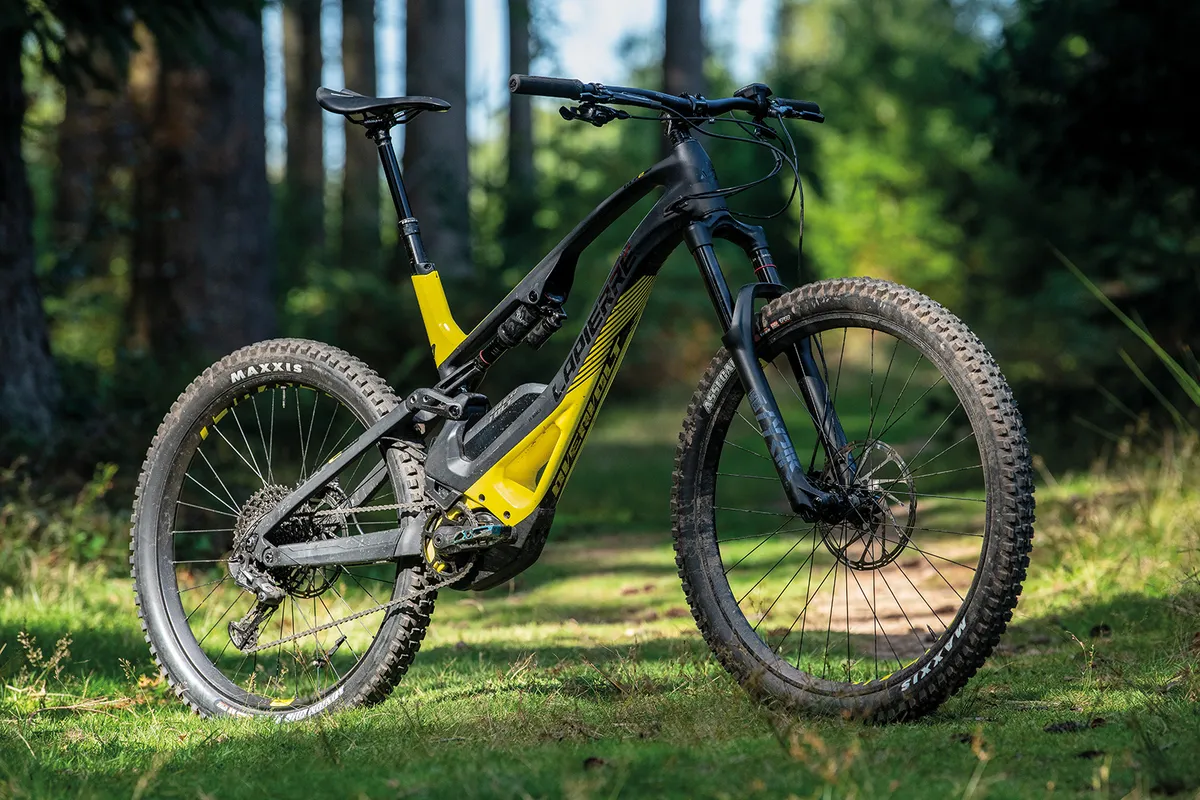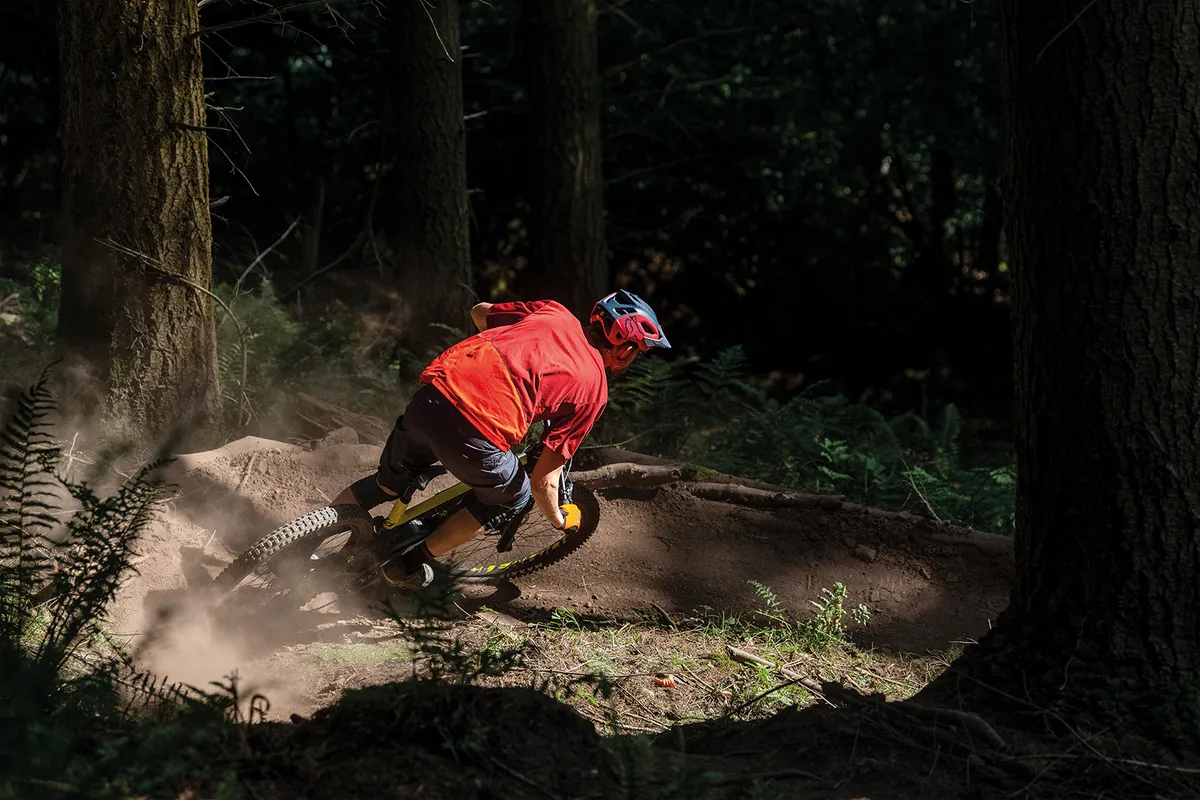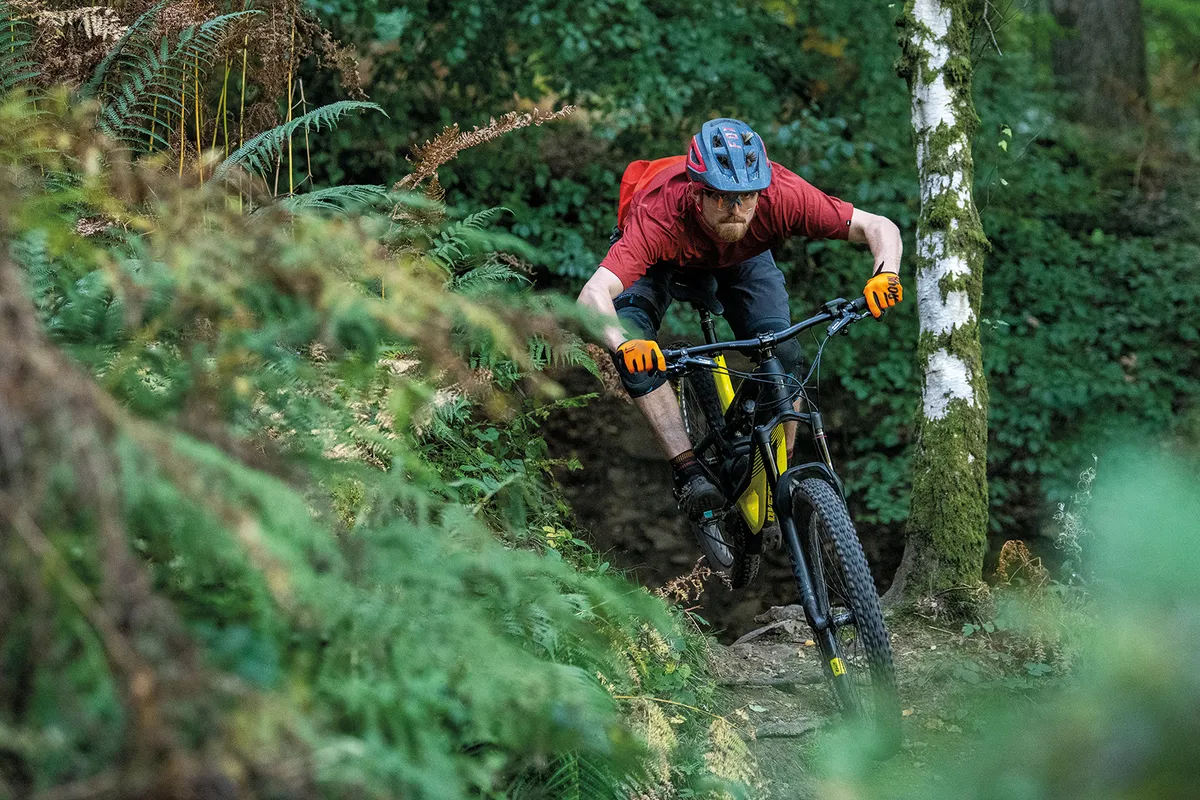Lapierre designed the Overvolt GLP to compete in the emerging ebike racing scene (yes, it’s a thing). Nico Vouilloz and Yannick Pontal have both won on theirs. But how is it outside the tape?
Lapierre Overvolt GLP 2 Elite frame and kit
The external battery is positioned above the motor to keep the weight lower and more central in the frame. It only has a 500Wh capacity, which is 20 per cent less than the 625Wh power packs found elsewhere, but, at 2.6kg, it’s 900g lighter.
Add a full-carbon frame and the Lapierre weighs 2.7kg less than the next-lightest bike I had on test, the Orbea Wild FS H10. There’s no space for a bottle, but you can stash a spare tube in the hollow triangle in front of the motor. The Horst link suspension delivers 160mm of travel. It’s possible to increase the shock stroke to boost this to 165mm.

A ‘mullet’ set-up sees the Overvolt GLP equipped with a 29 x 2.5in front wheel/tyre and a 27.5 x 2.8in out back. SRAM Guide REs with 220/200mm rotors provide powerful braking.
The Bosch Purion display/controller on the bar is easy to use, but lacks the cadence info and other data of a Kiox display. While the Select-level RockShox suspension performed well, the dropper post and bar let the side down.
Lapierre Overvolt GLP 2 Elite geometry
| | S | M | L | XL |
|---|---|---|---|---|
| Seat angle (degrees) | 79 | 76 | 76 | 76 |
| Head angle (degrees) | 65 | 65 | 65 | 65 |
| Chainstay (cm) | 44 | 44 | 44 | 44 |
| Seat tube (cm) | 39 | 43 | 46 | 50 |
| Top tube (cm) | 57.8 | 61 | 64.2 | 67.6 |
| Head tube (cm) | 10 | 11 | 12 | 13.5 |
| Bottom bracket drop (cm) | 1.5 | 1.5 | 1.5 | 1.5 |
| Stack (cm) | 61.5 | 62.5 | 63.4 | 64.7 |
| Reach (cm) | 61.5 | 62.5 | 63.4 | 64.7 |
Lapierre Overvolt GLP 2 Elite ride impressions
Let’s start with the bad news. The small battery means the Lapierre is down on range compared to its rivals. You can buy a second battery for around £550, though, as well as a pack designed to carry it.
Even with a second battery, the Lapierre is comparable in weight and price to Mondraker's Crafty R 29.
The main issue with the Overvolt GLP arises on steep climbs. Although the effective seat angle is similar to that of the other two bikes I had on test, it’s much harder to stop the front wheel lifting when the gradient increases, requiring taller testers to bend double.
This is partly down to the short 440mm back end, the more rearward battery placement and the bike’s low anti-squat figure, which means the rear suspension slouches further into its travel under power.

Running less sag (28 per cent) while removing a volume spacer to retain access to full travel helped a little, but the seat angle still felt too slack for steep inclines. The low bottom bracket and mid-length 165mm cranks make pedal strikes common too.
Descending performance is stymied by the shortest dropper post on test (supposed to have 150mm of travel, but I measured 142mm) and the 760mm bar, which is narrow for an XL bike, and too low as well.
These limited my movement when tackling steep drops, so I swapped to a higher-rise 800mm bar and resorted to dropping the saddle manually for steep descents. With a wider bar and lower seat height, the Overvolt came alive.

Hopping and manualling over obstacles, it feels more like a ‘normal’ mountain bike, with the centralised weight and shorter chainstays making it far easier to ride dynamically over big rocks and roots, while the long front-centre allows you to take on challenging lines with confidence.
However, the front wheel feels noticeably less planted than on the other bikes, requiring a more aggressive, over-the-front riding style, as well as softer fork and firmer shock pressures, to get it to grip consistently. I also ran the fork’s rebound slightly slower than usual and the shock fully open to help with this.
This may be less of an issue on the smaller frame size, and once I was more familiar on the bike, I was able to get more out of the ride.
For me, the Lapierre’s agility is worth the compromise in front-end grip compared to the Mondraker. The low bottom bracket makes it eager to change direction, so I can forgive the pedal strikes too.
One big advantage it has is the Guide RE brakes with big rotors, which provide ample power and a consistent lever feel. The ability to stop quickly every time adds to the feeling of responsiveness, which is unparalleled here.
How we tested
We put three of the latest £5,000+ ebikes to the test on a range of terrain, from technical climbs to flowing singletrack and full-bore DH tracks.
All of the bikes have 150mm to 160mm of rear wheel travel and use Bosch’s super-powerful fourth-generation Performance Line CX drive unit – Shimano’s latest EP8 motor came out too late for this test – to remove the variable of power delivery and let us focus on the differences in handling.
The bikes were set up tubeless, weighed and measured, then checked to ensure they had the same shock sag and comparable tyre pressures to begin with.
Next, we made changes to get the most out of the bikes, experimenting with suspension settings, bar height and contact points and then tested back-to-back on the same varied test loop on the same day, for the fairest possible comparison.
Also tested:
Product
| Brand | lapierre |
| Price | 5399.00 GBP |
| Weight | 22.1000, KILOGRAM (XL) - |
Features
| Fork | RockShox Lyrik Select, 160mm (6.3in) travel |
| br_stem | Lapierre, 45mm |
| br_chain | SRAM NX Eagle |
| br_frame | Carbon fibre, 160mm (6.3in) travel |
| br_motor | Bosch Performance Line CX Gen 4 with a Bosch 500Wh battery |
| Tyres | Maxxis Assegai 29x2.5in (f), Maxxis Minion DHR II 27.5x2.8in (r) |
| br_brakes | SRAM Guide RE, 220mm/200mm rotors |
| br_cranks | E*thirteen e*spec Plus, 34t |
| br_saddle | Lapierre |
| br_wheels | Lapierre eAM+ |
| br_headset | FSA Orbit 1.5 ZS |
| br_shifter | SRAM GX Eagle (1x12) |
| br_cassette | SRAM PG-1210, 11-50t |
| br_seatpost | Lapierre 142mm dropper (measured) |
| br_gripsTape | Lapierre |
| br_handlebar | Lapierre, 760mm |
| br_rearShock | RockShox Super Deluxe Select+ |
| br_availableSizes | S, M, L, XL |
| br_rearDerailleur | SRAM GX Eagle |
